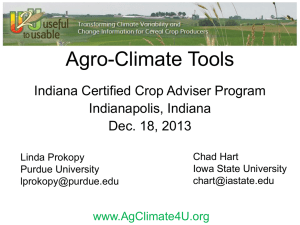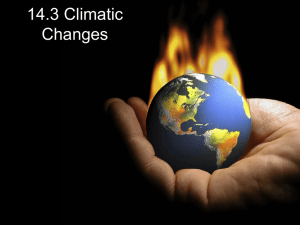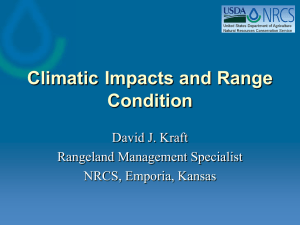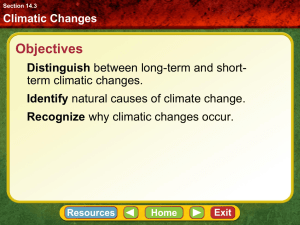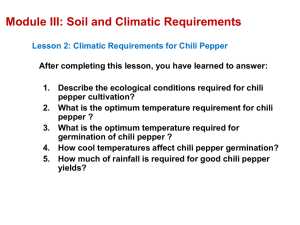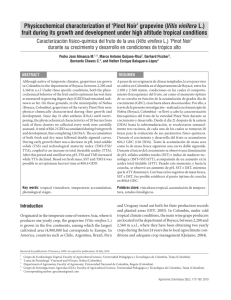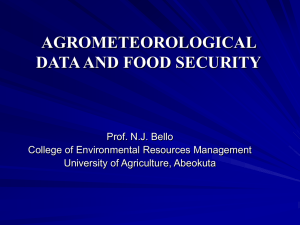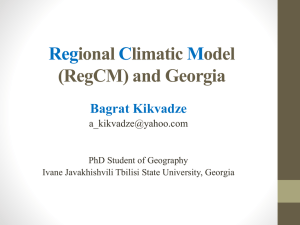Climatic Variability
advertisement
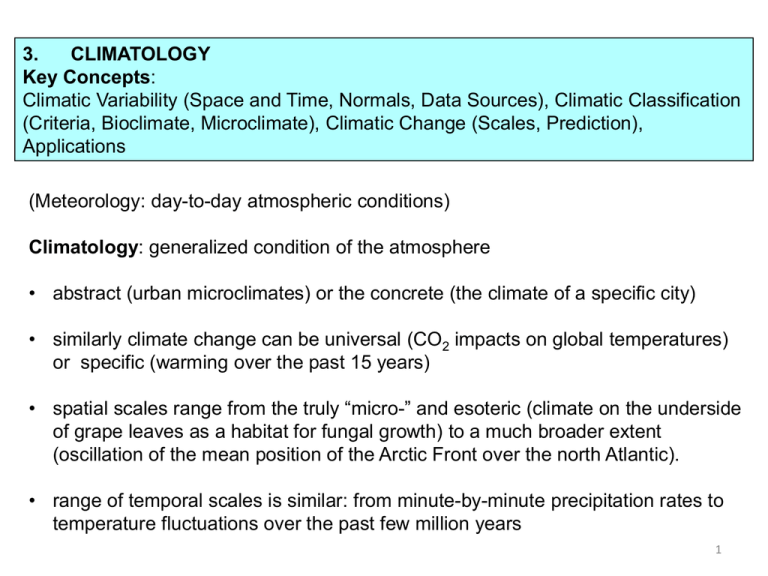
3. CLIMATOLOGY Key Concepts: Climatic Variability (Space and Time, Normals, Data Sources), Climatic Classification (Criteria, Bioclimate, Microclimate), Climatic Change (Scales, Prediction), Applications (Meteorology: day-to-day atmospheric conditions) Climatology: generalized condition of the atmosphere • abstract (urban microclimates) or the concrete (the climate of a specific city) • similarly climate change can be universal (CO2 impacts on global temperatures) or specific (warming over the past 15 years) • spatial scales range from the truly “micro-” and esoteric (climate on the underside of grape leaves as a habitat for fungal growth) to a much broader extent (oscillation of the mean position of the Arctic Front over the north Atlantic). • range of temporal scales is similar: from minute-by-minute precipitation rates to temperature fluctuations over the past few million years 1 Climatic Variability • Climate is often described as a discrete spatial phenomenon (i.e. climatic zones– the tropics, temperate climates, arctic climate, urban microclimates) • and discrete temporal episodes of climatic conditions are also often described (e.g. dirty thirties, Little Ice-age, post-glacial epoch, Jurassic Period, even “summer”) • However, both space and time can also be regarded as continuous dimensions: • variability may be uninterrupted: temperatures could conceivably vary every nano-second, or every nanometre, and would have to be lumped together to form discrete units • It is important to recognize this since it demonstrates that climatic zones (and episodes) are not uniform: there is variability no matter how specifically we measure atmospheric properties. 2 Climatic Variability (continued) • Climatology: the science that looks at atmospheric regularity (patterns) • By recognizing what is expected for a site at a specific point in time can be anomalies, or significant change be deciphered • to know what is abnormal, a clear image of what is normal must first be established. • to confirm that there is actual global warming, current temperatures must be confirmed to be warmer than what is “normal” • Climatologists examine the same measurement records of atmospheric properties as meteorologist, but seek to summarize them • daily daytime highs and night-time low temperatures can represent the typical diurnal conditions for each day of the year • despite the fact that we recognize time as continuous, the day is such a meaningful discrete unit, that it is universally recognized in reporting actual and expected conditions. • We expect a general pattern of higher daytime than night-time temperatures, knowing full well that there can be exceptions 3 To look at temperature trends spatially we map them and interpolate (usually linearly), or take a spatial mean (e.g. the mean of the nearest n weather stations, or all stations within n kilometres, or within zones otherwise defined). Spatial Averages calculated for zones: Inner ring zone spatial average: (18+19+24+22)/4 = 21 Outer ring zone spatial average: (21+23+25+27+23+ 24+22+28+25+27)/10 =23 Outside zone spatial average: (22+20+29+21+23+28+26)/7=24 Analysis if variance could test statistical significance of differences between versus differences within groups 4 Temporal trends can also be identified by averaging (mean of hourly observations, running mean observations). The short-term fluctuations are thereby reduced and longer patterns become emphasized – observed and 1951-1980 normal values are graphed, with the latter a much smoother trend: line A running mean plots the average of an observation and its n preceding and succeeding values. For instance a five-year running mean would plot for each year, an average of that year with the two preceding and following years, to show that episode in comparison with others. 5 Anomalies are exceptions to a pattern – significantly different from “normal” or expected values. It is common for these to be casually observed: summers are warmer than before; it was the coldest winter in memory. Statistical procedures add credibility. 6 • atmospheric variables are truly variable • is it a change or the normal range of variability that is being observed? • statistical answers rely on the probability of extreme values being observed, which are dependent on the extremes observed so far • Care must be taken in overemphasizing the trend from limited observation, and therefore, caution must be exercised in predicting climate. Ongoing monitoring of atmospheric conditions continues in an attempt to improve our scientific understanding and wisdom, but has revealed a great deal of variability. 7 Data Sources Summaries for Canadian centres’ stations with data with at least 15 years of data are available at: http://climate.weatheroffice.gc.ca/climate_normals/index_e.html “Normal” Monthly and Annual values for: Temperature (°C) Daily Mean, Standard Deviation, Daily Maximum, Daily Minimum Precipitation Rainfall (mm), Snowfall (cm), Precipitation (mm), Mean Snow Depth (cm), Median Snow Depth (cm), Snow Depth at Month-end (cm) Days With: Freezing Rain or Freezing Drizzle, Thunderstorms, Hail Days With Maximum Temperature: > 35 °C, > 30 °C, > 20 °C, > 10 °C, > 0 °C, <= 0 °C Days With Minimum Temperature: > 0 °C, <= 2 °C, <= 0 °C, <= -2 °C, <= -10 °C, <= -20 °C, <= -30 °C Days With Rainfall: >= 0.2 mm, >= 5 mm, >= 10 mm, >= 25 mm Days With Snowfall: >= 0.2 cm, >= 5 cm, >= 10 cm, >= 25 cm Days With Precipitation: >= 0.2 mm, >= 5 mm, >= 10 mm, >= 25 mm Days With Snow Depth: >= 0.2 cm, >= 5 cm, >= 10 cm, >= 25 cm, >= 50 cm, >= 100 cm Degree Days: Above 24 °C, Above 18 °C, Above 15 °C, Above 10 °C, Above 5 °C, Above 0 °C, Below 0 °C, Below 5 °C, Below 10 °C, Below 15 °C, Below 18 °C 8 Climatic Classification/ Criteria • The simplest of classification systems are binary ones; these can be as straightforward as yes/no categories (e.g. does it snow?) • Decisions are sometimes reduced to this level of logic, but further categories (i.e. maybe) may be unnecessary for understanding; it is more informative and acceptable to express atmospheric phenomena more precisely • Risk mapping, for instance for insurance purposes, benefits from intricacy both in its probability categories and in its mapping. • Weather-related risks include: probability of floods, droughts, hail, severe winter storms (blizzards, ice storms), lightning, tornadoes, hurricanes and windstorms • Public and private sector infrastructure is in place to monitor and predict these infrequent though high-peril events • Advisories, watches and warnings apply to weather events, but climatologically the risk may more difficult to assess. Insurance companies maintain proprietary risk mapping and schedule premiums to reflect this in the policies of their clients. http://www.metoffice.gov.uk/insurance/abi-report.html 9 • atmospheric properties climatologists are most concerned with tend to be temperature and precipitation. • Climates could be categorized statistically; principles of numerical taxonomy have been employed in many other sciences. • One relatively simple and logical basis for classifying climates could therefore be to conceptualize binary conditions for each property: Hot wet, hot dry, cold wet cold dry, (like air masses) • quantile maps are often used to display precipitation and temperature. Statistical classifications take advantage of the power of mathematics to classify climatic data objectively, but can only be as good as the range of data collected. This often under-represents extremes. 10 • Climate classification can be complex, involving many atmospheric properties (such as were include in the definition of comfort zones) or can be as simple as a single measure (temperature zones/episodes) • They can also be devised as a summation of scientific understanding serving a broad array of applications • Often, comprehensive climate classification systems seek to identify the nature of climatic regimes for the planet, by quantitatively defining types of zones and mapping their extents, typically relying on monthly and annual averages, but commonly have a biological bias (climate zones designed to match vegetation zones); e.g. Koppen (or Koppen-Geiger), Trewartha or Thornthwaite climatic classification systems • The scientific-researcher community and agencies responsible for or utilizing climatic data seem to have limited use for these systems’ categories • Gradients cannot exist with this approach, yet it is our personal observation that climatic properties do not have inherent boundaries 11 • The innovative approach of Bryson (1966) and others was to map climatic regions based on frequencies of air masses, rather than specific ranges of temperature and precipitation values. • Bryson’s maps depict where air masses dominate and transition zones are found in conjunction with the mean seasonal positions of fronts. • He demonstrates that coinciding with these are the locations of ecological regions (boreal forest and tundra). • With Larsen (1965) Bryson used this association to project backward from palæo-botanical evidence to reconstruct past climates in central North America • Evidence of past bio-regions as indicative of past climates relies on a strong association between climatic conditions and life zones 12 Bioclimate In practical applications, there is considerable interest in the climatic range of living organisms: • ranging from maintaining parks • to crop modification which would expand production zones • and pest management concerns: • disease epidemiology, • micro-habitats favouring fungi moulds or parasites, • breeding success of insects or crops’ competitors (weeds). 13 Agro-climate Classification Climate classification for agricultural purposes has sought measures for understanding the successes of crops under spatially and temporally variable growing conditions By knowing what may be limiting production, objectives for hybridization or gene manipulation programs may be established At the farm level, choices must be made regarding what to grow (crop type, specific hybrid variety, and rotation practice) and how to grow it (when to plant, treat (fertilize, spray, irrigate) and when to harvest it The “growing season” or frost-free period was commonly used as a simple measure of agricultural potential, but more than the average span from last spring frost to first fall frost is required 14 Growing Degree Days (GDD) • provide a surrogate measure of the energy available for plant growth • based on the assumption that warmer (more sensible heat) is better for crops • each day over a base temperature (usually 5°C), times the number of degrees over 5°C is tallied through the year • For instance: 1 day at 6° = 1 degree day, 10 days at 6°= 10 degree days 1 day at 15° = 10 degree days, 10 days at 15° = 100 degree days Days below 5°C do not contribute to the sum. 1. determine the mean temperature for the day: (max-min)/2 2. base temperature is then subtracted from the mean temperature to give a daily GDD 3. if the daily GDD calculates to a negative number it is made equal to zero The daily GDD is then added up (accumulated) over the growing season. Generally the larger the accumulated GDD is the greater the plant or insect development. Details of the calculation are provided by: http://sis.agr.gc.ca/cansis/nsdb/ecostrat/1999report/egdd.html http://sis.agr.gc.ca/cansis/nsdb/ecostrat/district/climate.html http://www.omafra.gov.on.ca/english/crops/facts/GDDOntario.htm http://www.omafra.gov.on.ca/english/crops/pub811/10using.htm 15 The Ontario Ministry of Agriculture, Food and Rural Affairs (OMAFRA) uses various base temperatures and produces reports for three basic ones: 3, 5 and 10°C and uses April 1 as a start date for accumulations. In the sample map of GDD from Manitoba, degrees days are expressed above a base temperature of 5°C.: 16 Vine & Tree Fruit INnovations User Manual http://www.vineandtreefruitinnovations.com/userguide.cfm#gddmap GDD Tool: In addition to the GDD map, a table of growing degree days will display if the user clicks on a value/station on the map. This table is shown in the figure below. A user can subsequently choose a start and end date and the total accumulated GDD for that period is displayed immediately above the table. This information will give growers a sense of the week, the month, the year, or any time period that is chosen, in terms of it accumulating more or less heat units The GDD tool runs from April 1 to October 31. To access the GDD tool from the home page map, click on a region ▶ GDD ▶ Click on a value/station 17 Degree-day examples: Crop or Insect Base Temperature (°C) General Plant Growth 5 Spinach 2.2 Lettuce 4.4 Peas and Asparagus 5.5 Corn and Beans 10 Pumpkins and Tomatoes 13 General Insect Development, House flies 15 Cabbage Maggot 6 Variegated Cutworm 7 Grasshoppers, Corn Borers 10 GDD indicates similarities among the major cool climate viticulture regions: http://www.inniskillin.com/vineyard/index.asp ?location=vineyard Geisenheim, Germany Epernay, France (Champagne) Hawk's Bay, New Zealand Roseburg, Oregon Geneva, Switzerland Beaune, France (Burgundy) Niagara, Canada (Ontario) Oliver, Canada (British Columbia) Yakima,Washington Napa, California Healdsburg, Sonoma, California 1050 1050 1200 1250 1250 1315 1426 1423 1426 1450 1755 18 Similar are calculations undertaken to classify areas according to their buildings’ energy requirements for heating (HDD) and cooling (CDD), commonly based on 18°C. Days above 18°C do not contribute to the sum. 1 day at 17° = 1 heating degree day, 10 days at 17° = 10 heating degree days 1 day at 8° = 10 heating degree days, 10 days at 8° = 100 heating degree days 1 day at -2° = 20 heating degree days, 10 days at -2° = 200 heating degree days Monthly HDD Values for Fredericton, N.B. http://www.atl.ec.gc.ca/climate/degrsamp.html J F M A M J J A S O N D 782 808. 0 622. 0 453. 8 241. 5 60.2 8.1 28.5 200. 6 255. 1 499. 7 800. 9 Frost degree days (and thaw degree days) are also used in predicting snow and ice conditions in the north for engineering projects. These may include concerns for the construction and maintenance of building foundations, roads and pipelines. 19 In an attempt to improve on the concept of Growing Degree Days, “Crop Heat Units” (originally corn heat units; CHU) have been developed to measure the climatic conditions favouring plant growth. Daily CHU are calculated from diurnal minimum and maximum temperatures, with 10°C as the daytime base temperature and 30°C as the optimum. The night time relationship uses 4.4°C as the base temperature. http://www.gov.on.ca/OMAFRA/english/crops/facts/93-119.htm As with GDD, mapping of the reveals potential areas for crop expansion and provides a quantitative measure of crop suitability. http://sis.agr.gc.ca/cansis/nsdb/climate/crop_heat/intro.html 20
